 |
| April 27, 2021 | Volume 17 Issue 16 |
Designfax weekly eMagazine
Archives
Partners
Manufacturing Center
Product Spotlight
Modern Applications News
Metalworking Ideas For
Today's Job Shops
Tooling and Production
Strategies for large
metalworking plants
What motors drive the Mars Ingenuity helicopter?
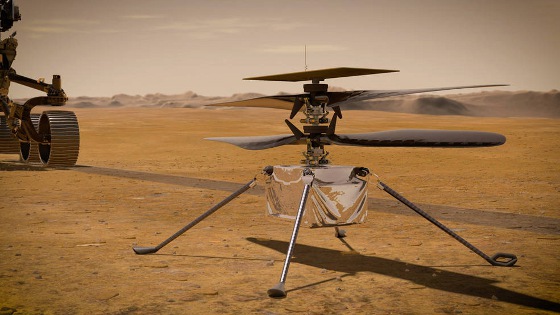
In this illustration, NASA's Ingenuity Mars Helicopter stands on the Red Planet's surface as NASA's Perseverance rover (partially visible on the left) rolls away. [Credits: NASA/JPL-Caltech]
[Article Update: Ingenuity has completed nine flights on Mars now (the last was July 5) since this article was first written at the end of April. For more updates, go to mars.nasa.gov/technology/helicopter/.
NASA's Mars Ingenuity helicopter, which weighs about 4 lb (1.8 kg) on Earth and has a fuselage about the size of a tissue box, has made three historic, short flights on the Red Planet now, but did you ever wonder what's inside?
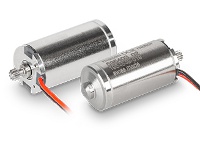
maxon's modified model DCX 10S motor is used for control of the Mars Helicopter swashplate, adjusting the inclination of the rotor blades to control the vehicle. [Picture: ©maxon motor]
What motors drive its two 4-ft-wide carbon fiber counter-rotating blades? Who makes them, and how many does it take to power flight?
They are motors from maxon (made in Switzerland). maxon's drives have a long, successful history in space applications, including in the Perseverance rover that carried the Ingenuity helicopter to Mars and landed on the planet on February 18, 2021.
There are 10 maxon BLDC motors utilized on the Perseverance rover and a special gearbox that will be used, among other things, to handle the soil samples inside the rover. One of these motors has already successfully completed its task: It placed the Mars helicopter safely on the ground so it could begin its first pre-flight checks.
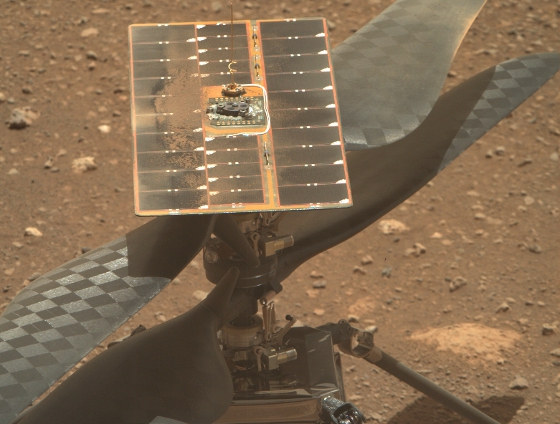
Close-up view of some of the maxon DCX motors on Ingenuity on Mars.
The Ingenuity helicopter is equipped with six brushed DC motors that have been specifically modified for this challenge. The maxon DCX series of drives control the pitch of the rotor blades and the direction of flight for the helicopter. Each customized DCX 10S motor weighs 7.1 g (without cabling) and has a diameter of 10 mm.
Ingenuity's lightweight design was a prerequisite for successful flight on the Red Planet, where there is hardly any atmosphere, comparable to conditions at an altitude of 30 km on Earth. Engineers at maxon worked closely with AeroVironment, the company that NASA's Jet Propulsion Laboratory contracted to design and build the helicopter's propulsion system.
"The biggest challenge in developing the motors was the extreme weight requirement," said Aiko Stenzel, design engineer at maxon. "Every tenth of a gram had to be saved to make the helicopter fly. What's great is that despite the weight savings, we found a drive solution that has enough power to adjust the rotor blades -- and this in the face of high vibrations and temperature fluctuations."
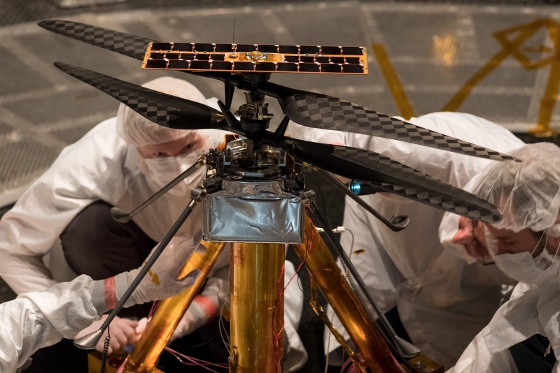
Bigger than you thought? Members of the NASA Mars Helicopter team inspect the flight model (the actual vehicle that went to the Red Planet) inside the Space Simulator, a 25-ft-wide vacuum chamber at NASA's Jet Propulsion Lab in Pasadena, CA, on Feb. 1, 2019. [Credits: NASA/JPL-Caltech]
A standard, off-the-shelf maxon DCX 10S motor weighs 6.3 g, which is under .25 oz. It has a max speed rating of 14,300 rpm. The maxon description for this motor says, "Like all motors in the DCX series, this brushed DC motor excels through high power density and low vibration. The DCX 10S exceeds the 1-mNm threshold during continuous use. With its mechanical output power of up to 1.4 W with a 10-mm diameter, it is a real powerhouse."
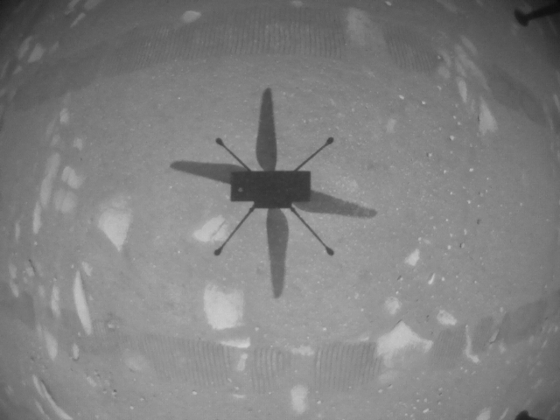
Ingenuity's camera photographed the ground and its own shadow during its maiden flight on Mars on April 19, 2021.
The standard variants of the DCX motors are available for everyone and can be configured online according to the individual customer specifications at shop.maxongroup.us.
Ingenuity's first successful flight on Mars took place on April 19, 2021. The helicopter climbed to its prescribed maximum altitude of 10 ft and maintained a stable hover for 30 sec. It then descended, touching back down on the surface of Mars after logging a total of 39.1 sec of flight.
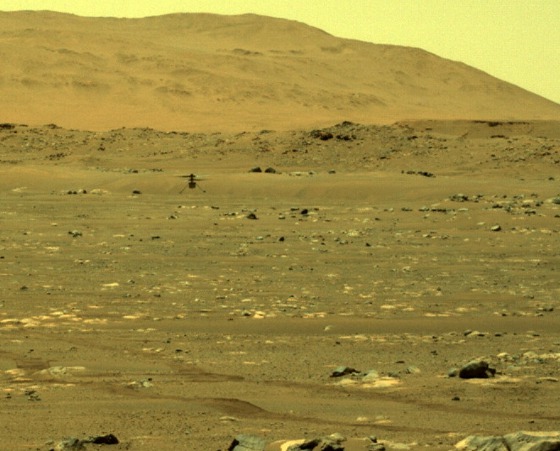
Taken by the Perseverance rover, this image shows the Ingenuity helicopter during its first flight on Mars.
VIDEO: Second flight a success for NASA's Ingenuity Mars Helicopter on April 22, 2021.
Ingenuity successfully completed its second Mars flight on April 22. This was the 18th sol (Martian day) of its experimental flight-test window. The flight lasted 51.9 sec and added several new challenges to the first, including a higher maximum altitude, longer duration, and sideways movement.
For its third flight on April 25, 2021, the helicopter flew faster and farther than in any tests it went through on Earth. It rose 16 ft (the same altitude as its second flight) and flew downrange 164 ft (just over half the length of a football field), reaching a top speed of 6.6 ft/sec.
What's next? A NASA statement on April 22 said, "The Ingenuity team is considering how best to expand the profiles of its next flights to acquire additional aeronautical data from the first successful flight tests on another world." We will see if NASA decides to push the craft to its limit -- and maybe even crash out the copter in doing so.
Back at maxon, there has been a lot of well-deserved pats on the back happening. Eugen Elmiger, CEO of the maxon Group, watched the NASA transmission of the first flight data live on April 19.
"It is a fantastic feeling to know that our precision drives worked as planned, and that we were able to make our contribution to this historic event," said Elmiger. "I am proud of our employees and look forward to the next milestones on Mars."
Sources: maxon, NASA
Published April 2021
Rate this article
View our terms of use and privacy policy
